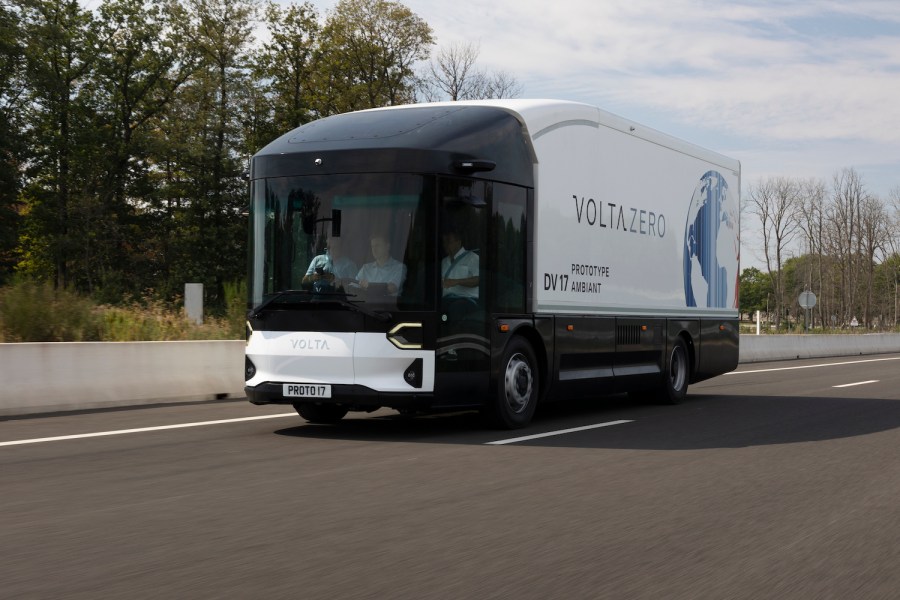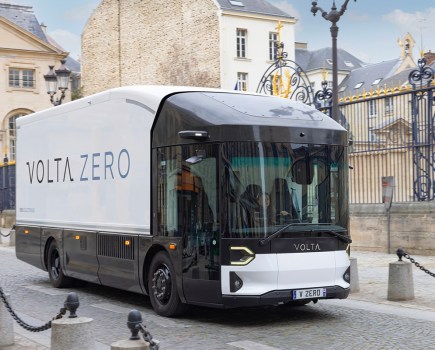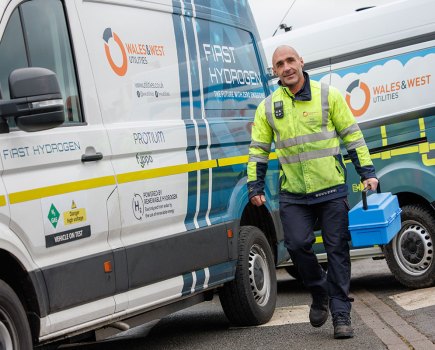Start-up electric truck maker Volta is positioning its new Volta Zero as a future-facing city distribution champ. We were among the first to strap into the 16-tonne prototype’s central driving seat and take it for a test drive – and the results were interesting, to say the least…
New commercial vehicle start-up Volta is billing its new Volta Zero as ‘the reinvented electric truck for urban distribution’. First revealed back in 2020, the fully electric Zero will initially be available in 16- and 18-tonne variants.
Still in prototype stage, customer testing is slated to begin early next year ahead of an official launch in London and Paris a few months later. Wider launches across Europe and the US will follow, ahead of the release of 7.5- and 12-tonne models towards the end of 2024.
According to company founder Carl-Magnus Norden, the overall goal is to shift 22,500 vehicles across Europe and North America by 2025.
Volta is hoping to attract interest from operators working in city centres where low emission zones (LEZs) are in force. It already has some significant orders from DB Schenker (1470 vehicles) and Petit Forestier (1000 vehicles) on its books.
Measuring up
Manufactured by Steyr Automotive in Austria, the 16-tonne Zero has a quoted range of up to 200 km (124 miles) per charge. It can be fitted with two or three 75 kWh Proterra battery packs delivering 150-225 kWh of power. It measures 9200 mm in length, 3470 mm high and 2550 mm wide. Its wheelbase is 4800 mm with a turning circle of 14 m.
Zero is available with ambient or refrigerated bodies. Ambient bodies are built by Paneltex and offer a payload of up to eight tonnes and room for 16 Euro pallets. Chilled models are by Lecapitaine and quote a payload of seven tonnes, carrying up to 15 Euro pallets. It uses Carrier Transicold’s Iceland tech for refrigeration (see page 24). Dhollandia retractable tailgates can also be fitted.
Volta’s unique cab concept features oversize windows, large glass panels mounted in bus-style sliding doors, and a driving position which is low and uniquely central. The manufacturer argues this affords the safest environment for the driver and other road users. With 220 degrees of eye-level direct visibility, the Zero has a Direct Vision Standard (DVS) rating of five stars firmly in its sights.
Blind spots are further reduced by digital side-view cameras, a 360-degree bird’s-eye camera showing a complete image of the truck’s surroundings, and blind-spot warning systems that detect objects at the sides of the vehicle. Interestingly, a screen akin to a ‘car-like’ rear-view mirror is also positioned high on the windscreen above the driver.
Futuristic build
Designed from scratch with no ‘legacy’ trappings, Volta Zero has a futuristic look that sets it apart from other electric trucks. The likes of DAF’s LF Electric, Renault’s E-Tech D or Volvo’s FL Electric all look like traditional commercial vehicles – as you’d expect from legacy diesel truck makers, where the (admittedly simplified) short-term goal seems to be making an electric drivetrain work in an existing chassis using as many common components as possible.
As a case in point, when we tried out Volvo’s electric heavy range back in the Summer issue, we noted how the Swedish manufacturer was attaching electric motors (one, two or three depending on model) directly to an adapted I-Shift gearbox linked to a driveshaft and rear axle, with the batteries mounted on either side of the chassis rails.
In contrast, Volta is using an eAxle from Meritor – a single unit combining the electric motor, transmission and rear axle to deliver power directly to the rear wheels. Volta Zero will be the first commercial vehicle in Europe to use Meritor’s kit, which is claimed to be lighter and more efficient than a conventional electric motor and axle set-up. This helps increase operational range, it reckons.
Another benefit is an eAxle frees up space between the chassis rails, which enables Volta to position batteries centrally between the rails for better impact protection.
On the track
Before we get stuck into our driving impressions, we must highlight the vehicle we were given to trial was a design verification prototype. Hand-built by Astheimer in Coventry, only 25 models currently exist – and we were warned prior to our test that some aspects of the truck (eg, fit and finish, and some ancillary systems such as air conditioning) might not be quite up to production standards.
Fair enough – everybody has to start somewhere. So with that in mind, we headed to Paris on September 1 to take the Zero for a good few laps around the UTAC test track just outside the French capital to see what it was like to drive.
Stepping into the 16-tonne ambient Zero is a lot like stepping onto a bus. Its low cab makes entry extremely easy, which we can already see will be a definite benefit for multi-drop drivers who are required to enter and exit the vehicle numerous times in a typical working day.
Cross-cab access is unobstructed, so drivers can exit either side without hassle – and the sliding doors are designed to reduce the risk of whacking other road users or passing traffic when they open.
Inside, the cab looks as futuristic as the exterior. There are mirror screens mounted on the corner pillars, two large portrait-format screens either side of the driver showing ancillary controls and vehicle information, plus a large driver information panel behind the wheel.
Not everything is digital. Beneath the two side screens are buttons giving analogue control for door release, interior lights, fog lights, central locking, hill hold and standard Drive, Neutral and Reverse transmission toggles. For everything else, you’ll be poking a screen.
After strapping into the central driving seat, we pushed the Start button, flicked to Drive and hit the accelerator. Sadly, our vehicle wasn’t loaded so we can’t comment on its effective pulling performance other than to say like all other electric trucks we’ve tried, power delivery is immediate, smooth and very torquey. Accelerating out onto the curving track, our Zero got up to speed quickly and responded positively as we steered it around the first lap.
Middle ground
As we’d suspected, it took us a while to adapt to the central driving position. We’re well used to testing right- and left-hand drive trucks, so a change of perspective does not usually bother us. However, we found the Zero’s centre seat caused us to drift towards the road’s middle line at first, as if we were subconsciously aligning to our usual biased driving position.
It took a few laps before we’d ‘trained’ ourselves into sitting comfortably in the centre of the lane. It’s something to bear in mind – especially as drivers will be carefully threading these trucks through tight, double-parked roads etc in city centres. We can see a few dings and dents occurring in the early days!
That said, all-round visibility from the low driving position is excellent. Being eye-level with pedestrians is a benefit, and the large glass doors will make spotting cyclists that have pulled up beside the truck so much easier. We did feel quite exposed sitting low-down right at the front of the cab, though it doesn’t seem to bother bus and coach drivers too much so it’s probably something else we’ll get used to.
However, one downside of having so much glass around the driver is it can get very hot in the cab. It was sunny 32 degrees C on the day of our test, and the air conditioning inside the Zero was struggling to keep us cool – especially with three people in the cab. We were warned the air con wasn’t yet fully up to speed; but it highlights how much drivers will need to rely on it during the warmer months. Big glass doors mean there are no windows to open for a bit of fresh air. And of course, you’ll have to open the doors and get out of your seat to press buttons or use an intercom at barriers etc, as they’ll be well out of reach.
One other foible we noticed was the steering wheel obscured the digital speedo at the top of the screen behind it. At 6 ft 4 inches, we sit quite high and were unable to see the readout without some significant ducking or stretching. Hopefully this will be addressed in a future revision.
Work in progress
The cab interior still feels like a work in progress. With a seat positioned behind the driver’s right and left shoulders, there’s hardly any storage aside from bottle/paperwork holders by the driver’s left and right knees. We were told there will be overhead lockers in production vehicles, so we’ll wait and see what the final design is like.
Similarly, some build materials will also change. Our test truck had carbon fibre body panels, but you can be sure these will be replaced for production models. Again, we’ll wait and see how much this will affect handling and payload (if at all).
Overall though, our runs around the track in the Volta Zero was a good experience. After reporting on the truck’s development milestones since 2020, it was great to finally get behind the wheel. It’s clear there’s still much to be done before final launch next year, and it will be fascinating to see how the next iteration will evolve.
Verdict
Like every electric truck we’ve driven so far, the Volta Zero offers a positive drive. The smooth and powerful acceleration from the Meritor eAxle should be a good match for stop/start urban deliveries, and the visibility from the prototype’s ‘goldfish-bowl’ cab seems excellent – as is entry and exit. It’s a fully digital experience, which might well be a turn-off for some drivers; but conversely, Volta is hoping its futuristic design will tempt younger drivers to get behind the wheel.
There’s not much else we can say about our driving impressions at this stage. The prototype goes well and behaves as we’d expect, but we’ve yet to see how it performs with a load on. And of course, a lot can change between prototype and production. We already know there will be alterations made to the design and materials before launch next year, so we’ll keep our powder dry for now and look forward to delivering a final verdict on the Zero then.
We like:
+ eAxle gives nippy performance
+ Excellent all-round visibility
+ Easy entry/exit from either side
We don’t like:
– Steering wheel obstructs speedo
– Production specs still unclear
– Still to test with a payload
SPECIFICATIONS
Model: Volta Zero
Design gvw: 16,000 kg
Chassis: Front axle: 6500 kg capacity
Rear axle: 11,000 kg capacity, 4800 mm wheelbase, full air suspension
Max payload: 7750 kg
Engine: Electric Meritor eAxle
Battery size: Up to 246 kWh gross, 225 kWh usable
Range: Up to 200 km/124 miles per charge
Additional equipment: Three seats including central driving seat, ambient box body with roller doors, low-entry cab with sliding doors






